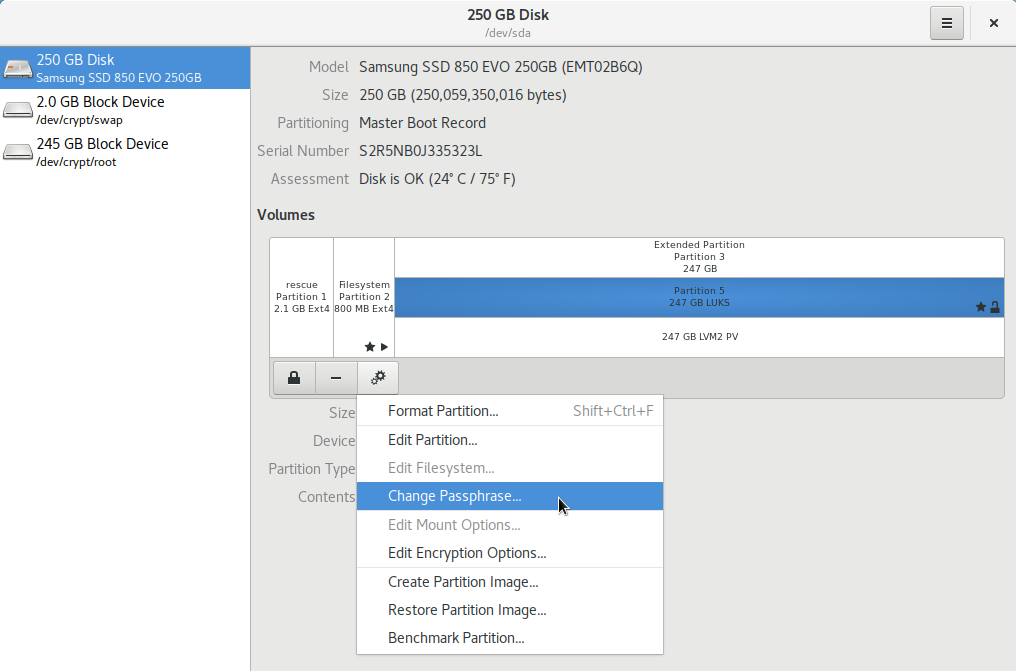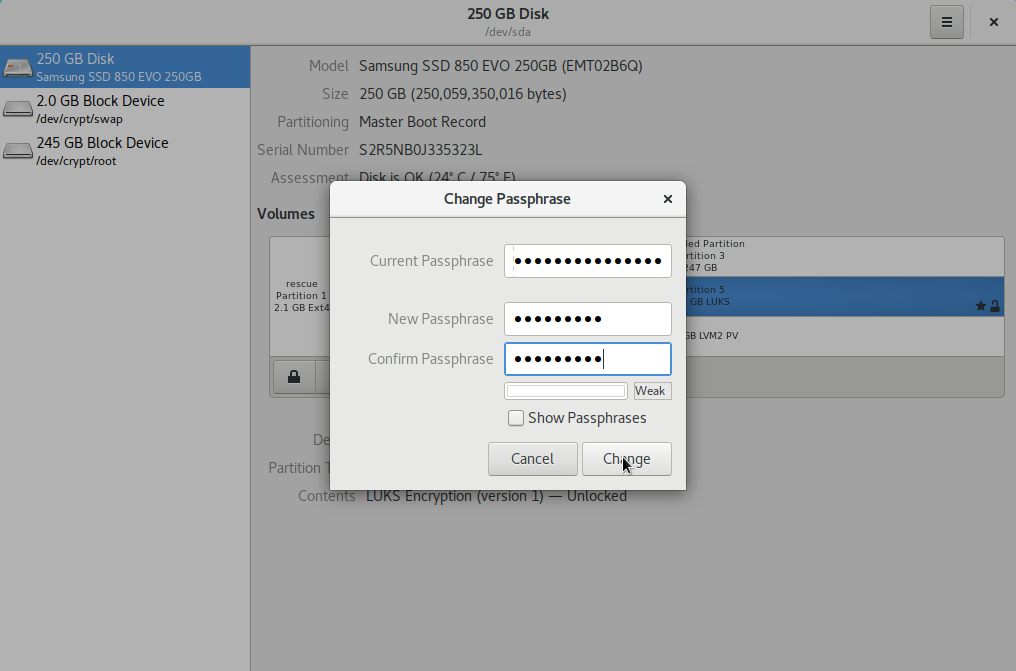Change the disk encryption passphrase¶
This guide describes how to change the passphrase of an encrypted LVM partition.
Important
You might want to backup your data to an external hard disk before doing this, as a precaution.
Laptops and desktops¶
Method 1: Using the terminal¶
LUKS allows for an encrypted partition/system to have multiple passwords and also to remove them. To change the password, we first add the new password and then remove the old one.
Get the name of the encrypted volume
Open a terminal emulator and issue the following command:
lsblk
It will show you the name of the partition.
Ignore /boot and /swap.
test@test-pc:~$ lsblk
NAME MAJ:MIN RM SIZE RO TYPE MOUNTPOINT
sda 8:0 0 20G 0 disk
├─sda1 8:1 0 1,1G 0 part /boot
├─sda2 8:2 0 10,5G 0 part
│ └─luks-92d57f72-cb7f-431e-8446-052f1d569dd3
│ 254:0 0 10,5G 0 crypt /
└─sda3 8:3 0 8,4G 0 part
└─luks-23b1ab2d-064e-4d58-a365-9c84a4d55cd7
254:1 1 8,4G 0 crypt [SWAP]
sr0 11:1 1 1,5G 0 rom /media/test/PureOS 8.0 GNOME Live
test@test-pc:~$ █
Note
In this case the encrypted volume is called sda2 but your computer can have a different name.
Make sure you adjusted these commands to with the name of your device!
Add a new password
Issue the following command in a terminal emulator:
sudo cryptsetup luksAddKey /dev/device_name
It will ask you for your user password. Type it and press
Enter.
test@test-pc:~$ sudo cryptsetup luksAddKey /dev/sda2
[sudo] password for test: █
Next you will be asked for the old disk encryption password. Type it and press
Enter.
test@test-pc:~$ sudo cryptsetup luksAddKey /dev/sda2
[sudo] password for test:
Enter any existing passphrase: █
Type the new password you want for the encrypted disk, then press enter
test@test-pc:~$ sudo cryptsetup luksAddKey /dev/sda2
[sudo] password for test:
Enter any existing passphrase:
Enter new passphrase for key slot: █
Confirm the new password and press
Enter
test@test-pc:~$ sudo cryptsetup luksAddKey /dev/sda2
[sudo] password for test:
Enter any existing passphrase:
Enter new passphrase for key slot:
Verify passphrase: █
The new password is now added.
Removing the old password
Issue the following command in a terminal emulator:
sudo cryptsetup luksRemoveKey /dev/device_name
Type the password that you want to delete and press
Enter.
Method 2: Using GNOME Disks¶
Launch GNOME Disks and click the encrypted volume you wish to change the password for. Click the gear icon and select Change Passphrase…:

Enter your current and new password:

Librem 5¶
Method 1: Using the terminal¶
You can use the exact same method as described for laptops.
Either from the device terminal application or from ssh.
Method 2: Using GNOME Disks¶
Launch GNOME Disks:

Select the storage device:

Select the LUKS partition and press the settings button:

Select Change Passphrase:

Type your
USERpassword, and press Authenticate:

Type in their respective fields:
Current Disk Encryption Passphrase
New Passphrase
Confirm the new Passphrase
Press Change
